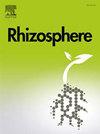Chrysin alleviates salt stress in tomato by physiological, biochemical, and genetic mechanisms
IF 3.4
3区 生物学
Q1 PLANT SCIENCES
引用次数: 0
Abstract
Soil salinity greatly reduces agricultural productivity, especially in dry and semi-arid regions, by interfering with physiological and biochemical processes. This research aimed to determine whether Chrysin (Chr) can mitigate the negative effects of salinity on growth parameters, antioxidant enzyme activity, and gene expression in tomato (Solanum lycopersicum L.) plants. Experiments were conducted in a semi-controlled greenhouse, with plants subjected to varying concentrations of sodium chloride (NaCl) (0 and 100 mM) and Chr (0, 0.1, 0.5, and 1.0 mM). Results revealed that salinity stress significantly reduced plant height, leaf area, and chlorophyll content while increasing hydrogen peroxide (H2O2), malondialdehyde (MDA), and proline levels, indicating oxidative stress. Chr application alleviated these detrimental effects by enhancing the activity of antioxidant enzymes such as catalase (CAT), peroxidase (POD), and superoxide dismutase (SOD), thereby reducing reactive oxygen species (ROS) accumulation. Additionally, Chr treatments improved plant water status and mineral content under salt stress. Gene expression analysis showed that Chr positively regulated the transcription of salt tolerance-related genes, including HKT1-1, HKT1-2, and PIP1-2, which are associated with sodium ion transport and water balance. These findings suggest that Chr can be an effective biostimulant for enhancing salt tolerance in tomato plants by modulating physiological, biochemical, and genetic mechanisms. This study provides insights into Chr's potential as a sustainable solution for improving crop resilience to salinity in agricultural practices. Further research is recommended to optimize Chr concentrations for maximum efficacy.
菊粉通过生理、生化和遗传机制缓解番茄的盐胁迫
土壤盐分会干扰生理和生化过程,从而大大降低农业生产力,尤其是在干旱和半干旱地区。本研究旨在确定金黄素(Chr)是否能减轻盐分对番茄(Solanum lycopersicum L.)植株生长参数、抗氧化酶活性和基因表达的负面影响。实验在半控制温室中进行,对植物施加不同浓度的氯化钠(NaCl)(0 和 100 mM)和 Chr(0、0.1、0.5 和 1.0 mM)。结果表明,盐胁迫明显降低了植株高度、叶面积和叶绿素含量,同时增加了过氧化氢(H2O2)、丙二醛(MDA)和脯氨酸水平,表明存在氧化胁迫。施用 Chr 可提高过氧化氢酶(CAT)、过氧化物酶(POD)和超氧化物歧化酶(SOD)等抗氧化酶的活性,从而减少活性氧(ROS)的积累,从而减轻这些不利影响。此外,Chr 处理还改善了盐胁迫下植物的水分状况和矿物质含量。基因表达分析表明,Chr 能正向调节耐盐相关基因的转录,包括 HKT1-1、HKT1-2 和 PIP1-2,这些基因与钠离子转运和水分平衡有关。这些发现表明,Chr 可以通过调节生理、生化和遗传机制,成为提高番茄植株耐盐性的有效生物刺激剂。这项研究深入探讨了 Chr 作为一种可持续的解决方案,在农业实践中提高作物抗盐碱能力的潜力。建议进一步开展研究,优化 Chr 的浓度,使其发挥最大功效。
本文章由计算机程序翻译,如有差异,请以英文原文为准。
求助全文
约1分钟内获得全文
求助全文
来源期刊

Rhizosphere
Agricultural and Biological Sciences-Agronomy and Crop Science
CiteScore
5.70
自引率
8.10%
发文量
155
审稿时长
29 days
期刊介绍:
Rhizosphere aims to advance the frontier of our understanding of plant-soil interactions. Rhizosphere is a multidisciplinary journal that publishes research on the interactions between plant roots, soil organisms, nutrients, and water. Except carbon fixation by photosynthesis, plants obtain all other elements primarily from soil through roots.
We are beginning to understand how communications at the rhizosphere, with soil organisms and other plant species, affect root exudates and nutrient uptake. This rapidly evolving subject utilizes molecular biology and genomic tools, food web or community structure manipulations, high performance liquid chromatography, isotopic analysis, diverse spectroscopic analytics, tomography and other microscopy, complex statistical and modeling tools.
 求助内容:
求助内容: 应助结果提醒方式:
应助结果提醒方式:


